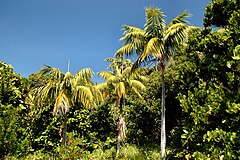Howea forsteriana
| Howea forsteriana subsp. var. | Kentia Palm, Sentry Palm, Paradise Palm, Thatch palm | |||||||||||||||||||||||||||||||||||||||||||||||||||||||
|---|---|---|---|---|---|---|---|---|---|---|---|---|---|---|---|---|---|---|---|---|---|---|---|---|---|---|---|---|---|---|---|---|---|---|---|---|---|---|---|---|---|---|---|---|---|---|---|---|---|---|---|---|---|---|---|---|

|
|
| ||||||||||||||||||||||||||||||||||||||||||||||||||||||
| ||||||||||||||||||||||||||||||||||||||||||||||||||||||||
The Kentia palm or Thatch palm (Howea forsteriana) is endemic to Lord Howe Island. It is also widely grown on Norfolk Island. Its "fronds" or leaves grow up to 3 metres long.
The species is considered vulnerable by the World Conservation Union. It is cultivated on Lord Howe Island by collecting wild seeds and germinating them for export worldwide as an ornamental garden or house plant. The trade in the seeds and seedlings is tightly regulated.
The palm is an elegant plant, and is popular for growing indoors, requiring little light. Out of doors, it prefers a tropical region but will also grow in a cooler climate, and can tolerate temperatures down to -5 °C, but only for a few hours; normal temperatures should not go below 10°. It grows readily outside in areas such as southern Australia and northern New Zealand, where it is fairly common in private gardens or as a street tree. In the Northern Hemisphere, it can be grown as far north as SW England, and grows well in the south of Spain and the southernmost parts of the USA, and will bear flowers and fruit. The coasts of the southeastern Azores and Madeira offer similar climates to its original habitat. It is slow growing, but will eventually reach heights of 6 to 18 metres. Under natural conditions, it grows as a solitary tree. Germination of the seeds is erratic.
The closely related Belmore sentry palm (Howea belmoreana), also endemic on Lord Howe Island, is a smaller species to 7 metres tall, found mainly as an understorey plant in moist forests.
| Standard Cyclopedia of Horticulture |
|---|
|
Howea forsteriana, Becc. (Kentia Forsteriana, F. Muell. Grisebdchia Forsteriana, H. Wendl. & Drude). Flat or Thatch-leaf Palm.
|
Cultivation
Propagation
Pests and diseases
Varieties
Gallery
References
- Standard Cyclopedia of Horticulture, by L. H. Bailey, MacMillan Co., 1963
External links
- w:Howea forsteriana. Some of the material on this page may be from Wikipedia, under the Creative Commons license.
- Howea forsteriana QR Code (Size 50, 100, 200, 500)


